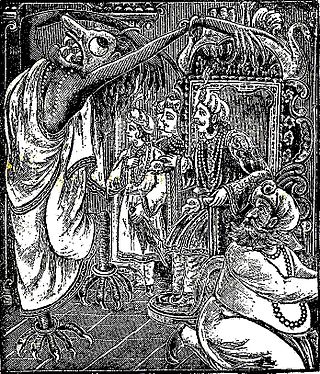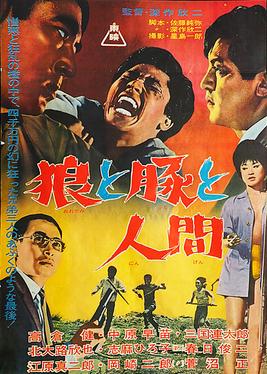
In folklore, a ghost is the soul or spirit of a dead person or non-human animal that is believed to be able to appear to the living. In ghostlore, descriptions of ghosts vary widely, from an invisible presence to translucent or barely visible wispy shapes to realistic, lifelike forms. The deliberate attempt to contact the spirit of a deceased person is known as necromancy, or in spiritism as a séance. Other terms associated with it are apparition, haunt, haint, phantom, poltergeist, shade, specter, spirit, spook, wraith, demon, and ghoul.

Hungry ghost is a term in Buddhism, and Chinese traditional religion, representing beings who are driven by intense emotional needs in an animalistic way. The terms 餓鬼èguǐ literally "hungry ghost", are the Chinese translation of the term preta in Buddhism which is a Sanskrit word. "Hungry ghosts" play a role in Chinese Buddhism and Taoism as well as in Chinese folk religion. The term is not to be confused with the generic term for "ghost" or damnation, 鬼guǐ. The understanding is that all people become such a regular ghost when they die, and would then slowly weaken and eventually die a second time.

The Joy Luck Club is a 1989 novel written by Amy Tan. It focuses on four Chinese immigrant families in San Francisco who start a club known as The Joy Luck Club, playing the Chinese game of mahjong for money while feasting on a variety of foods. The book is structured similarly to a mahjong game, with four parts divided into four sections to create sixteen chapters. The three mothers and four daughters share stories about their lives in the form of short vignettes. Each part is preceded by a parable relating to the themes within that section.

Japanese horror is horror fiction derived from popular culture in Japan, generally noted for its unique thematic and conventional treatment of the horror genre differing from the traditional Western representation of horror. Japanese horror tends to focus on psychological horror, tension building (suspense), and the supernatural, particularly involving ghosts (yūrei) and poltergeists. Other Japanese horror fiction contains themes of folk religion such as possession, exorcism, shamanism, precognition, and yōkai. Media in which the genre of Japanese horror fiction can be found include artwork, theater, literature, film, anime and video games.

Preta, also known as hungry ghost, is the Sanskrit name for a type of supernatural being described in Hinduism, Buddhism, Taoism, and Chinese folk religion as undergoing suffering greater than that of humans, particularly an extreme level of hunger and thirst. They have their origins in Indian religions and have been adopted into East Asian religions via the spread of Buddhism. Preta is often translated into English as "hungry ghost" from the Chinese and East Asian adaptations. In early sources such as the Petavatthu, they are much more varied. The descriptions below apply mainly in this narrower context. The development of the concept of the preta started with just thinking that it was the soul and ghost of a person once they died, but later the concept developed into a transient state between death and obtaining karmic reincarnation in accordance with the person's fate. In order to pass into the cycle of karmic reincarnation, the deceased's family must engage in a variety of rituals and offerings to guide the suffering spirit into its next life. If the family does not engage in these funerary rites, which last for one year, the soul could remain suffering as a preta for the rest of eternity.

A Touch of Zen is a 1971 wuxia film written, co-edited and directed by King Hu. Its screenplay is based on a classic Chinese story "Xianü" in the book Strange Stories from a Chinese Studio by Pu Songling. The film is set in the Ming dynasty under the dominance of eunuchs and explores a variety of themes including the transcendence of dichotomies, Zen Buddhism, feminism, conservative female roles, and the ghost story.

The Nightmare Room is an American children's anthology horror series that aired on Kids' WB. The series was based on the short-lived children's book series that went by the same title created by Goosebumps author, R. L. Stine. The Nightmare Room originally aired from August 31, 2001, to March 16, 2002, in the United States.
The Amityville haunting is a modern folk story based on the true crimes of Ronald DeFeo Jr. On November 13, 1974, DeFeo shot and killed six members of his family at 112 Ocean Avenue, Amityville, on the south shore of Long Island. He was convicted of second-degree murder in November 1975. In December 1975, George and Kathy Lutz and their three children moved into the house. After 28 days, the Lutzes left the house, claiming to have been terrorized by paranormal phenomena while living there. The house became the subject of numerous investigations by paranormal researchers, journalists, and skeptics, including Ed and Lorraine Warren. These events served as the historical basis for Jay Anson's 1977 novel The Amityville Horror, which was followed by a number of sequels and was adapted into a film of the same name in 1979. Since then, many films have been produced that draw explicitly, to a greater or lesser extent, from these historical and literary sources. As Amityville is a real town and the stories of DeFeo and the Lutzes are historical, there can be no proprietary relationship to the underlying story elements associated with the Amityville haunting. As a result of this, there has been no restriction on the exploitation of the story by film producers, which is the reason that most of these films share no continuity, were produced by different companies, and tell widely varying stories.

Ghosts are an important and integral part of the folklore of the socio-cultural fabric of the geographical and ethno-linguistic region of Bengal which presently consists of Bangladesh and the Indian states of West Bengal and Tripura. Bengali folktales and Bengali cultural identity are intertwined in such a way that ghosts depicted reflect the culture it sets in. Fairy tales, both old and new, often use the concept of ghosts. References to ghosts are often found in modern-day Bengali literature, cinema, radio and television media. There are also alleged haunted sites in the region. The common word for ghosts in Bengali is bhoot or bhut. This word has an alternative meaning: 'past' in Bengali. Also, the word Pret is used in Bengali to mean ghost. In Bengal, ghosts are believed to be the unsatisfied spirits of human beings who cannot find peace after death or the souls of people who died in unnatural or abnormal circumstances like murders, suicides or accidents. Non-human animals can also turn into ghosts after their death. But they are often associated with good luck and wealth in Bangladesh.

Haunted Lives: True Ghost Stories was an American paranormal anthology television miniseries that originally broadcast from May 15, 1991 to November 28, 1995, on CBS and UPN. This short-lived program comprised three primetime specials that featured re-enactments of ghost stories told by real people who experienced alleged paranormal activity. The docudrama series used actors and special effects, and then introduced the witnesses who reported such phenomena.

Chinese folklore features a rich variety of ghosts, monsters, and other supernatural creatures. According to traditional beliefs a ghost is the spirit form of a person who has died. Ghosts are typically malevolent and will cause harm to the living if provoked. Many Chinese folk beliefs about ghosts have been adopted into the mythologies and folklore of neighboring East Asian cultures, notably Japan, Korea, and Vietnam. Beliefs about ghosts are closely associated with Chinese ancestor worship, where much have been incorporated into Buddhism and in turn influenced and created uniquely Chinese Buddhist beliefs about the supernatural.

Japanese Buddhist architecture is the architecture of Buddhist temples in Japan, consisting of locally developed variants of architectural styles born in China. After Buddhism arrived from the continent via the Three Kingdoms of Korea in the 6th century, an effort was initially made to reproduce the original buildings as faithfully as possible, but gradually local versions of continental styles were developed both to meet Japanese tastes and to solve problems posed by local weather, which is more rainy and humid than in China. The first Buddhist sects were Nara's six Nanto Rokushū, followed during the Heian period by Kyoto's Shingon and Tendai. Later, during the Kamakura period, in Kamakura were born the Jōdo and the native Japanese sect Nichiren-shū. At roughly the same time, Zen Buddhism arrived from China, strongly influencing all other sects in many ways, including in architecture. The social composition of Buddhism's followers also changed radically with time. Beginning as an elite religion, it slowly spread from the nobility to warriors and merchants, and finally to the population at large. On the technical side, new woodworking tools like the framed pit saw and the plane allowed new architectural solutions.
Kamen Rider Ghost is a Japanese tokusatsu drama serving as the 17th Heisei Kamen Rider Series, and 26th series overall. Takuro Fukuda serves as Ghost's lead screenwriter, with Satoshi Morota as director. It premiered on TV Asahi and affiliate stations throughout Japan on October 4, 2015, the week following the finale of its predecessor series Kamen Rider Drive, joining Shuriken Sentai Ninninger, and later, Doubutsu Sentai Zyuohger in the Super Hero Time programming block.

Wolves, Pigs and Men is a 1964 Japanese black-and-white crime film directed by Kinji Fukasaku.












